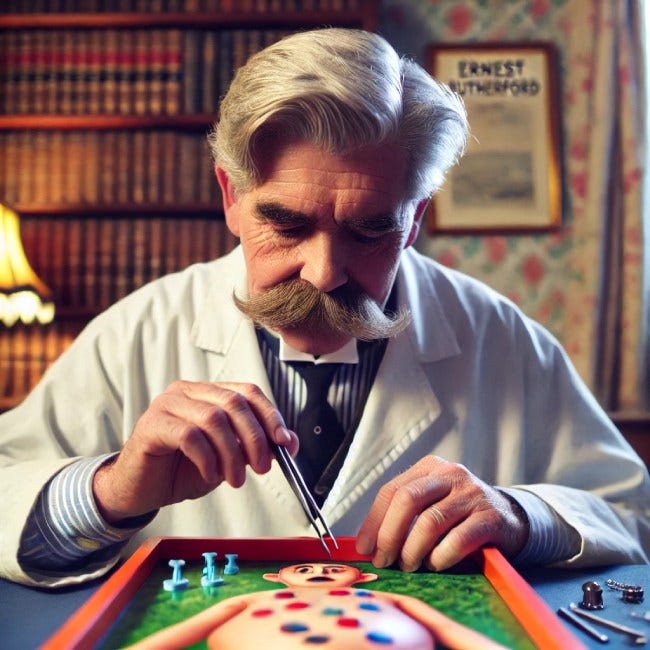Welcome to Tall Poppies
In each edition, I break down what makes great Kiwis … great!
Today, we’re going old school. We’re looking at the life and legacy of Ernest Rutherford. You know, the dude on the $100 bill you say goodbye to in exchange for 4 things at the supermarket?
Am I the only one who thinks that if he could split the atom, he could have also been the Operation World Champ?
When I see Ernest Rutherford, the first thing I think is:
“What a sweet mo.”
The second thing is:
“He’s the guy that split the atom eh?”
Admittedly, I didn’t even really know what that meant.
My vague recollection from high school is that if you split an atom, it makes a big kaboom.
After some research, I discovered that there’s splitting the atom, and then there’s SPLITTING THE MF ATOM!
"SPLITTING THE MF ATOM" refers to the process of nuclear fission, in which the nucleus of an atom is split into two or more smaller nuclei, releasing a significant amount of energy. This occurs when the nucleus of a heavy element, such as uranium-235 or plutonium-239, is bombarded with a neutron, causing it to become unstable and split apart.
Rutherford was the first to ‘split the atom’, which loosened the jar lid for a couple of German lads, Otto Hahn and Fritz Strassmann, to SPLIT THE MF ATOM.
Now we know what he did, let’s look at how he got there.
ORIGIN STORY
He was born in 1871 in Brightwater, which is kind of by Richmond, which is pretty much Nelson. There mustn’t have been much happening in Brightwater, as he was the fourth of twelve kids.
He had a typical Kiwi upbringing. His parents were hardworking, and things were tight, BUT his parents were big believers in education.
That belief, combined with Ernest being a bit of a geek, won him a scholarship to study at Canterbury College (back in the motherland, not Chch).
At 24, he packed his suitcase and grabbed the nonstop steamship to England.
There, he worked under the famous physicist J.J. Thomson. It didn’t take long for Rutherford to become the big dog on campus.
DISCOVERIES
His first major discovery was that radioactive elements have half-lives and identified alpha and beta radiation. I’m pretty sure at 24, I was figuring out what the half-life of a Jager bomb was. Top tip: it’s about 3.765 seconds.
But Rutherford wasn’t done yet. He had 11 siblings he had to outdo on Christmas day, remember? In 1911, he performed an experiment that would become known as his famous ‘gold foil experiment,’ which nuked the existing atomic model.
At the time, atoms were thought to be completely solid. The popular theory was the “Plum Pudding Theory,” which thought electrons moved around in a soup-like substance, like raisins in a pudding.
Rutherford discovered that atoms are mostly empty space with a tiny, dense nucleus at the centre. Empty space with a dense centre. Sounds a bit like the inside of my skull.
It’s hard to put this discovery in context, as an atom is an atom to us. It’s like working out that 1+1 is 3 or that the world isn’t flat; it’s a globe orbiting that big hot thing in the sky.
In 1917, Rutherford successfully turned nitrogen into oxygen. This experiment led to the first observed nuclear reaction, during which a proton was emitted. This was the first ‘splitting of the atom’.
FAST FORWARD TO TODAY…
Rutherford’s legacy lives on:
If Chemistry fogs up your glasses, you’ll probably remember Rutherfordium (element 104), which is named after the great man.
The Cavendish Laboratory at Cambridge, where he later became director, produces more Nobel laureates
AKA geeksthan anyone else.His nuclear model of the atom is still taught in schools all around the world over 100 years later.
However, what made Rutherford great wasn’t just his scientific knowledge. He was also an outstanding leader and mentor. He helped guide the careers of future scientific legends like Niels Bohr and James Chadwick, who continued Rutherfords’ legacy, shaping the course of physics for decades to come.
Here are a few quick takeaways:
Super-Efficient Meetings: The man didn’t just transform science—he also transformed meetings. It’s hard to believe, but university meetings in the early 19th could be a little bit on the longer side. Rutherford was known for wrapping up meetings quickly. One committee meeting he chaired famously lasted only two minutes.
Funny Exam Moment: Rutherford was famous for valuing creativity. One story has him grading a student who, instead of answering a physics question about how to measure a building’s height with a barometer, suggested lowering the barometer from the roof with a string. Rutherford didn’t just pass him—he raved to anyone who would listen about his lateral thinking.
Rutherford vs. Einstein: Though they respected each other, Rutherford once called Einstein’s theory of relativity “nonsense.” This wasn’t a personal dig—it was Rutherford’s practical approach. He was all about experiments, and theory didn’t always impress him. To Rutherford, it wasn't worth much if you couldn’t test it.
Ernest Rutherford passed away in 1937, but his impact can still be felt in every physics class worldwide.
He wasn’t just the best in his field. He created his own field, Atomic Physics.
Not bad for a kid from Brightwater
Until next time, keep your protons in your nucleus so you don’t go kaboom.
If you want more of these, leave a comment below, letting me know who you want to learn more about and subscribe below.






Loved this new column and yes its convinced me to subscribe (especially if you provide a link from NZ trails - one less click from column to column). Personally, I would mind reading your words on Kate Edger.
Love that this new column is your Christmas gift to us Brad - thank you! Definitely want more. Would enjoy reading your take on people like Ettie Rout, John Minto and Ian Athfield.